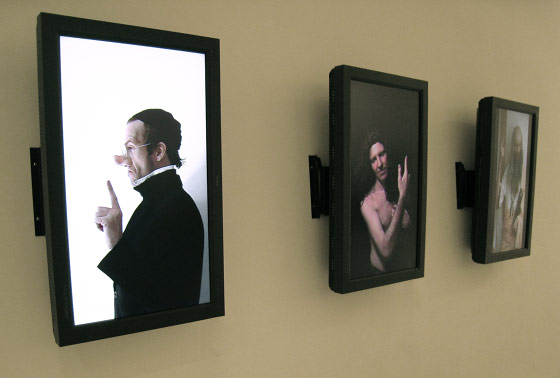
IndexFinger #1-3. A Video Triptych
IndexFinger #1 is part of a photographic video portrait series on the decisive role of a gesture, namely the index finger, throughout the history of religion, philosophy, and pop-culture.
#1 is a psycho-dramatic imitation of Wilhelm Busch's famous 19th century graphic novel, Max and Moritz (http://www.fln.vcu.edu/mm/mmeng4.html) which still plays an essential role in German-speaking popular culture. The depicted part is based on the illustration of the fourth trick. This segment focuses on Lehrer Laempel, the heamadster of the local school who is a feared moral authority. As the story unfolds he gets blown up by the two main characters who are child pranksters, Max and Moritz. The novel itself is a cautionary tale about the destructiveness and the drama resulting from going over the edge of naughtiness.
#2 is a psycho-dramatic imitation of Leonarda Da Vinci's famous oil painting, Saint John the Baptist, painted between 1513-1516, housed in the Louvre, Paris. Da Vinci's paintings often depict esoteric, androgynous characters with a slight touch of an almost diabolic darkness. John the Baptist shows the saint pointing towards somebody else, the gesture of a disciple towards his master.
#3 is a psycho-dramatic imitation of Raphael's famous fresco "The School of Athens" depicting the major philosophers of ancient Greece. One of its central figures, Plato, serves as a template for the 3rd video portrait, showing him while holding his right arm up and pointing with his index finger towards -- most likely -- the sun as a sympol for the scholastic trinity of the good, the whole, and the truth. Raphael's fresco from 1510-11, housed in the Museum of the Vatican, is frequently a focal point of an inflamed debate among art historians over its historical value, yet it was understood to be one of the central paintings introducing neoplatonism in Italy.
The video portraits were created by Richard Jochum and greatly supported by Aphrodite Désirée Navab. Altogether they constitute a tryptich installation which is part of the group exhibition, "What's Good Must Not Necessarily Be Evil", at Kunstraum Vaduz, Liechtenstein in April/May 2007.
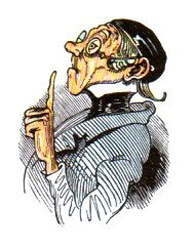

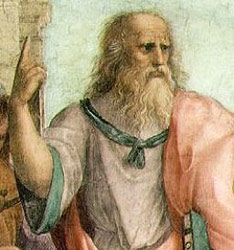
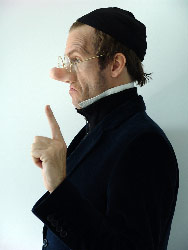
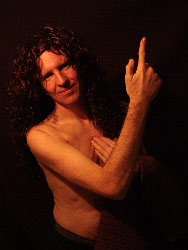
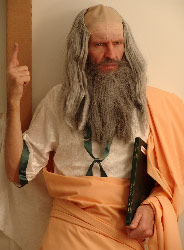
An exhibition catalogue will be published in May containing a text by Aphrodite Désirée Navab:
“Review of Richard Jochum’s IndexFinger series (2007)”
The joy of a boy running free with his father’s wardrobe is the playfulness you witness in Richard Jochum’s photographic video portraits: IndexFinger1-3 (2007). Whether it is putting on the costume of Plato as depicted in Raphael’s fresco, The School of Athens (1510-11), or of Leonardo Da Vinci’s St. John the Baptist (1513-1516), or the 19th century German cartoonist Wilhelm Busch’s comic strip character Lehrer Laempel, Jochum is trying on the clothes of significant figures in Western philosophy, history and religion. The three impersonations relate by virtue of a gesture, the index finger pointed upwards, as if in mid-sentence, as if an invitation for a conversation with the viewer: “Listen to what I say. I have something to say. I am pointing to this. I am pointing to that. I am warning you. I am teaching you. Forewarning, indicating and demonstrating with the index finger at the disciples and pupils of the future generations. Pay close attention to me. I have something to say…”
In a theater of display and play, Jochum’s wears the three personas with equal seriousness, humor, and charm. The index finger connects the three figures, but the meanings vary due to their historical context. The deepest form of flattery is imitation. Jochum is paying tribute to the personalities, while simultaneously teasing them for the gravity of their poses. The effect is that he winks at us in between the serious gestures. The low-budget quality of the costumes, props and lighting (as free as natural light), convey a home video atmosphere to the series, but leaving the viewers not really at home. Who would make home videos like this and why? Hilariously self-mocking, the figures stare at you as though you were walking for hours in a wax museum or hall of mirrors, where eyes that seem to be stationary begin to follow you. However, this museum is trans-national and cultural, where Jochum brings visual icons from the Louvre, the Vatican, and the comic strip, and relates them by one gesture: the index finger pointing upwards.
An indexical behavior or utterance, in the philosophy of language is one whose meaning varies according to the context in which it takes place. Now, here, and I are the most typical indexical terms. Originally from the Latin indicare, to indicate, index is at once here and there, occurring in the here but pointing to a there simultaneously; indicating and leading to a particular fact or conclusion. Indexicals are closely related to demonstratives like this or that, in that both vary in meaning depending on context. In order to successfully interpret indexicals the hearer/viewer must know the respective speaker, time and place of utterance.
Now we get into the deeper layers of Jochum’s IndexFinger series. Each of the three video portraits visually connects by virtue of an index finger pointed upwards, but the figure, time, place and meaning of each act is significantly different. Thus, they connect at the same time that they disconnect. And it is the space between the disruptions that allows the viewer to continue discovering connections between St. John the Baptist, Plato, and Lehrer Laempel. Each has an authority that comes from different systems of thought and belief: from Greek philosophy, Christianity, to an enormously popular German comic strip full of cautionary tales of the consequences of disobedience and mischief. All three connect as instructors. What Jochum does is wear the clothes of his teachers and step in as a student who sees both the gravity and the humor between the three systems of thought that have significantly influenced his own life. What we experience, therefore, is the collapse of the walls that kept these characters in history under different categories of high and low culture. Jochum’s IndexFinger series enables us to discern and interpret a visual culture rich with associations and interrelations.